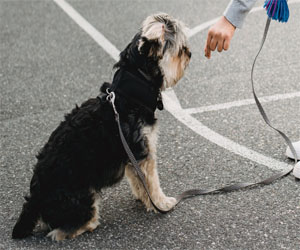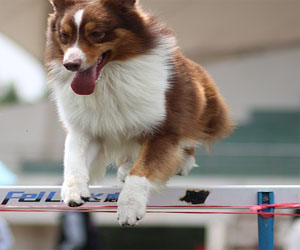


A Positive Approach To Obedience And Behavior

Reward-based dog training methods have gained immense popularity in recent years due to their humane and effective approach to teaching dogs obedience and good behavior. This method, also known as positive reinforcement training, focuses on rewarding desired behaviors with treats, praise, and affection. In this article, we'll explore the principles and benefits of reward-based dog training methods.
Principles Of Reward-Based Dog Training
Positive Reinforcement: Reward-based training revolves around positive reinforcement. This means that dogs are rewarded immediately for exhibiting desired behaviors. Whether it's sitting on command, coming when called, or any other action you want to reinforce, a reward follows to encourage repetition.
Timing Is Key: Timing is crucial in reward-based training. The reward must be given promptly, typically within seconds of the desired behavior occurring. This ensures that the dog associates the action with the reward.
Consistency: Consistency is vital in this training method. Everyone in the dog's life, from family members to caregivers, should follow the same rules and use the same commands to avoid confusion.
Clear Communication: Reward-based training requires clear communication between the dog and the trainer. Verbal cues, hand signals, or clickers are used to signal the desired behavior. These cues are followed by a reward when the dog complies.
Benefits Of Reward-Based Dog Training
Promotes Positive Behavior: Reward-based training encourages good behavior and helps dogs understand what is expected of them. It promotes a willingness to please and cooperation.
Strong Bond: This training method fosters a strong bond between the dog and the trainer. Dogs associate training with positive experiences and look forward to working with their owners.
Reduces Stress And Fear: Reward-based training is a gentle approach that minimizes stress and fear in dogs. It doesn't involve harsh punishments or intimidation, making it a less anxiety-inducing experience for your pet.
Enhances Problem Solving: Dogs engaged in reward-based training tend to develop better problem-solving skills. They learn to think and make choices in order to earn rewards.
Long-Lasting Results: The lessons learned through reward-based training tend to stick with dogs for the long term. Once they associate a behavior with a positive outcome, they are more likely to continue the good behavior even without immediate rewards.
How To Implement Reward-Based Training Effectively
Identify Desirable Behaviors: Start by determining the behaviors you wish to encourage in your dog, whether it's basic obedience commands or more advanced tricks.
Use High-Value Rewards: Choose rewards that are highly motivating for your dog. High-value treats, praise, or playtime with a favorite toy are often effective.
Timing: Reward your dog immediately after they exhibit the desired behavior. This immediate reinforcement helps them connect the action with the reward.
Consistency: Be consistent in your training efforts. Use the same cues, rewards, and rules every time you work with your dog.
Patience: Remember that every dog learns at their own pace. Be patient and encouraging, and avoid punitive measures that can hinder the training process.
Reward-based dog training methods are a positive and effective way to teach dogs good behavior and obedience. By rewarding desired behaviors with treats, praise, and affection, you create a positive and motivating learning experience for your furry friend. This method not only promotes positive behavior but also strengthens the bond between you and your pet. Whether you're working on basic commands or advanced tricks, reward-based training is a humane and successful approach to shaping well-behaved and happy dogs.
A Sustainable Path Forward
 2. Composting Organic Waste
2. Composting Organic Waste
A significant portion of landfill waste consists of organic materials such as food scraps and yard trimmings. Composting these materials not only reduces the volume of waste going to landfills but also produces valuable compost that can enrich soil and support sustainable agriculture. Composting is a simple yet effective way to reduce the environmental impact of landfill waste.
3. Waste-To-Energy Technology
Waste-To-energy (WTE) technology, as discussed in previous articles, is a powerful strategy for diverting waste from landfills and generating clean energy simultaneously. By incinerating waste at high temperatures, WTE facilities can significantly reduce waste volume and produce electricity and heat, making it a win-win solution for waste management and sustainable energy production.
4. Circular Economy Initiatives
The concept of a circular economy emphasizes designing products with end-of-life considerations in mind. Instead of creating products that become waste, the goal is to create items that can be repaired, reused, or easily recycled. This approach minimizes the need for landfill disposal and encourages resource conservation.
5. Extended Producer Responsibility (EPR)
EPR is a policy approach that places responsibility on manufacturers for the entire life cycle of their products, including the post-consumer phase. It encourages companies to design products that are easier to recycle and manage at the end of their life, thus reducing the waste that ends up in landfills.
6. Reducing Single-Use Plastics
Single-use plastics are a major contributor to landfill waste and environmental pollution. Strategies such as banning certain single-use plastics, promoting reusable alternatives, and encouraging recycling programs can significantly reduce the volume of plastic waste in landfills.
7. Public Awareness And Education
Effective waste reduction strategies rely on public awareness and education. Informing individuals about the environmental impact of landfill waste and providing guidance on reducing, reusing, and recycling can inspire behavioral change and promote sustainable practices.
A Thrilling World Of Canine Competition And Camaraderie
 Specialized dog sporting events like dock diving and flyball add a unique dimension to the world of dog sports. Dock diving involves dogs leaping off a dock into a pool to retrieve a thrown object, demonstrating their strength, agility, and love for water. Flyball is a relay race where teams of dogs hurdle over obstacles to trigger a spring-loaded box, releasing a tennis ball, which they then retrieve. These events offer excitement and a refreshing change of pace.
Specialized dog sporting events like dock diving and flyball add a unique dimension to the world of dog sports. Dock diving involves dogs leaping off a dock into a pool to retrieve a thrown object, demonstrating their strength, agility, and love for water. Flyball is a relay race where teams of dogs hurdle over obstacles to trigger a spring-loaded box, releasing a tennis ball, which they then retrieve. These events offer excitement and a refreshing change of pace.
Dog sporting events offer numerous benefits to both dogs and their owners. For dogs, these activities provide essential exercise and mental stimulation, contributing to their overall well-being. They also foster socialization, as dogs interact with other canines and their owners, helping them become more well-adjusted pets.
For dog owners, participating in sporting events is an opportunity to deepen their bond with their pets. The trust and teamwork required to excel in these events create a unique connection between the two, enhancing their companionship. It's a chance for owners to learn more about their dog's capabilities and build a stronger, more harmonious relationship.
Understanding And Fulfilling Their Needs
 2. Regular Veterinary Care
2. Regular Veterinary Care
Routine veterinary care is vital for monitoring and maintaining a cat's health. Regular check-ups, vaccinations, and preventive care help detect health issues early and ensure your cat receives the necessary treatments to stay happy and healthy.
3. Mental And Physical Stimulation
Cats are curious creatures that require mental and physical stimulation. Engage your cat with toys, puzzles, and interactive playtime. Activities like chasing feather wands, laser pointers, and treat-dispensing puzzles provide your cat with both mental and physical exercise, which contributes to their happiness.
4. Grooming And Hygiene
Grooming plays a significant role in a cat's happiness. Regular brushing helps prevent matting, reduces shedding, and provides an opportunity for bonding between you and your feline companion. Some breeds, particularly long-haired ones, may require more frequent grooming.
5. Safe Environment
Creating a safe and comfortable environment is essential for your cat's well-being. Ensure your living space is free of hazards, remove toxic plants and chemicals, and provide stimulating objects and areas for exploration. Cats appreciate window perches, scratching posts, and safe outdoor spaces if available.
6. Emotional Well-Being
Cats also have emotional needs. Spending quality time with your cat, offering them affection, and providing a loving and secure environment are crucial for their happiness. Building a strong bond with your cat leads to a contented and harmonious relationship.






Top Tips For Success
 2. Consistency Is Key: Consistency in training is vital. Use the same cues, commands, and techniques throughout your training sessions. Dogs respond well to predictability and repetition, so keeping things consistent helps them understand what is expected of them.
2. Consistency Is Key: Consistency in training is vital. Use the same cues, commands, and techniques throughout your training sessions. Dogs respond well to predictability and repetition, so keeping things consistent helps them understand what is expected of them.
3. Positive Reinforcement: Use positive reinforcement methods like treats, praise, and play to motivate and reward your dog during training. Dogs are more likely to learn and retain commands when they associate them with positive experiences.
4. Know The Rules: Familiarize yourself with the rules and regulations of the competition you're entering. Each event has specific guidelines and expectations, and understanding them is essential to ensure your dog's success.
5. Find A Qualified Trainer: Consider seeking the assistance of a professional dog trainer who specializes in the specific competition you're interested in. They can provide expert guidance and help you and your dog refine your skills.
6. Gradual Exposure: Gradually expose your dog to the competition environment. Start by practicing in familiar settings, then gradually introduce new elements, such as different locations, distractions, and other dogs. This helps your dog adapt to the competition environment.
7. Practice Under Pressure: Create situations that mimic the pressure of competition. Invite friends or fellow competitors to observe your training sessions.
Unraveling The Mysteries In The Fields
 Formation Techniques And Precision
Formation Techniques And Precision
One of the most compelling aspects of crop circle investigations is the examination of formation techniques and precision. Researchers have discovered that while some crop circles can be easily attributed to human-made efforts using ropes and boards, others exhibit remarkable precision and intricacy that challenge conventional explanations. These formations often display geometric shapes and mathematical properties that are difficult to achieve through simple means.
Elongated Crop Nodes
An intriguing finding in some crop circle investigations is the discovery of elongated crop nodes. In some formations, the crop plants exhibit elongation of their nodes, or the points where leaves and stems connect. This phenomenon is often associated with crop circles that have not been obviously man-made, leading researchers to investigate the potential mechanisms behind this plant response.
Magnetic Anomalies And Radiation
Researchers have noted magnetic anomalies and increased radiation levels in the vicinity of some crop circles. These findings have fueled speculation about the involvement of external forces or energy sources in the creation of certain formations. While these anomalies are intriguing, their connection to crop circle formation remains a subject of ongoing research and debate.